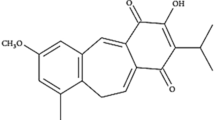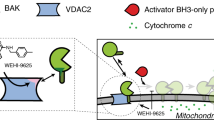Abstract
Labdane diterpenoids have a broad spectrum of biological activities including antibacterial, antiviral and anti-inflammatory properties. However, little is known about their possible role in the apoptotic cell death machinery. Here, we report that hispanolone derivatives, a group of labdane diterpenoids, induce apoptosis in different tumor cell lines by activating caspase-8 with subsequent participation of mitochondrial signaling. Activation of caspase-8 by hispanolone derivatives was followed by a decrease in mitochondrial membrane potential, the release of apoptotic factors from mitochondria to the cytosol, and activation of caspases-9 and 3. Hispanolone derivatives also led to a time-dependent cleavage of Bid. Inhibition of caspase-8 abrogated these processes, suggesting that the death receptor pathway has a critical role in the apoptotic events induced by hispanolone derivatives. In addition, silencing death receptors with small interfering RNA s or pretreating cells with neutralizing antibodies to Fas ligand, tumor necrosis factor receptor 1 (TNF-R1), and TNF-α receptor 2 (TRAIL) inhibited diterpenoid-induced apoptosis, revealing it to be dependent on these death receptors. Interestingly, hispanolone derivatives had no effect on non-tumor cells. Consistently, in vivo bioluminescence imaging corroborates this antineoplasic effect, as hispanolone derivatives significantly decrease cancer growth in tumor xenograft assays. These data demostrate the antitumoral effects of hispanolone derivatives and provide relevant preclinical validation for the use of these compounds as potent therapeutic agents in cancer treatment.
This is a preview of subscription content, access via your institution
Access options
Subscribe to this journal
Receive 50 print issues and online access
$259.00 per year
only $5.18 per issue
Buy this article
- Purchase on Springer Link
- Instant access to full article PDF
Prices may be subject to local taxes which are calculated during checkout






Similar content being viewed by others
References
Chinou I . Labdanes of natural origin-biological activities (1981–2004). Curr Med Chem 2005; 12: 1295–1317.
Girón N, Traves PG, Rodriguez B, Lopez-Fontal R, Bosca L, Hortelano S et al. Supression of inflammatory responses by labdane-type diterpenoids. Toxicol Appl Pharmacol 2007; 228: 179–189.
Song Z, Steller H . Death by design: mechanism and control of apoptosis. Trends Cell Biol 1999; 9: M49–M52.
Nicholson DW . Caspase structure, proteolytic substrates, and function during apoptotic cell death. Cell Death Differ 1999; 6: 1028–1042.
Peter ME, Krammer PH . Mechanisms of CD95 (APO-1/Fas)-mediated apoptosis. Curr Opin Immunol 1998; 10: 545–551.
Enari M, Talanian RV, Wong WW, Nagata S . Sequential activation of ICE-like and CPP32-like proteases during Fas-mediated apoptosis. Nature 1996; 380: 723–726.
Slee EA, Adrain C, Martin SJ . Serial killers: ordering caspase activation events in apoptosis. Cell Death Differ 1999; 6: 1067–1074.
Li H, Zhu H, Xu CJ, Yuan J . Cleavage of BID by caspase 8 mediates the mitochondrial damage in the Fas pathway of apoptosis. Cell 1998; 94: 491–501.
Savona G, Piozzi F, Rodriguez B . Hispanolone, a new furanoditerpene. Heterocycles 1978; 9: 257–261.
Rodriguez B, Savona G . Diterpenoids from Galeopsis Angustifolia. Phytochemistry 1980; 19: 1805–1807.
Xia YF, Ye BQ, Li YD, Wang JG, He XJ, Lin X et al. Andrographolide Attenuates Inflammation by Inhibition of NF-κB Activation through Covalent Modification of Reduced Cysteine 62 of p50. J Immunol 2004; 173: 4207–4217.
Zhou J, Zhang S, Ong CN, Shen HM . Critical role of pro-apoptotic Bcl-2 family members in andrographolide-induced apoptosis in human cancer cells. Biochem Pharmacol 2006; 72: 132–144.
Zhou J, Lu GD, Ong CS, Ong CN, Shen HM . Andrographolide sensitizes cancer cells to TRAIL-induced apoptosis via p53-mediated death receptor 4 up-regulation. Mol Cancer Ther 2008; 7: 2170–2180.
de Las Heras B, Abad MJ, Silvan AM, Pascual R, Bermejo P, Rodriguez B et al. Effects of six diterpenes on macrophage eicosanoid biosynthesis. Life Sci 2001; 70: 269–278.
Hwang BY, Lee JH, Koo TH, Kim HS, Hong YS, Ro JS et al. Kaurane diterpenes from Isodon japonicus inhibit nitric oxide and prostaglandin E2 production and NF-kappaB activation in LPS-stimulated macrophage RAW264.7 cells. Planta Med 2001; 67: 406–410.
Nagashima F, Kasai W, Kondoh M, Fujii M, Watanabe Y, Braggins JE et al. New ent-kaurene-type diterpenoids possessing cytotoxicity from the New Zealand liverwort Jungermannia species. Chem Pharm Bull (Tokyo) 2003; 51: 1189–1192.
Liby KT, Yore MM, Sporn MB . Triterpenoids and rexinoids as multifunctional agents for the prevention and treatment of cancer. Nat Rev Cancer 2007; 7: 357–369.
Dirsch VM, Antlsperger DS, Hentze H, Vollmar AM . Ajoene, an experimental anti-leukemic drug: mechanism of cell death. Leukemia 2002; 16: 74–83.
Kuo PL, Hsu YL, Lin TC, Lin LT, Lin CC . Induction of apoptosis in human breast adenocarcinoma MCF-7 cells by prodelphinidin B-2 3,3′-di-O-gallate from Myrica rubra via Fas-mediated pathway. J Pharm Pharmacol 2004; 56: 1399–1406.
Kelley SK, Ashkenazi A . Targeting death receptors in cancer with Apo2L/TRAIL. Curr Opin Pharmacol 2004; 4: 333–339.
Wajant H . CD95L/FasL and TRAIL in tumour surveillance and cancer therapy. Cancer Treat Res 2006; 130: 141–165.
Mann J . Natural products in cancer chemotherapy: past, present and future. Nat Rev Cancer 2002; 2: 143–148.
Wang CY, Cusack Jr JC, Liu R, Baldwin Jr AS . Control of inducible chemoresistance: enhanced anti-tumor therapy through increased apoptosis by inhibition of NF-kappaB. Nat Med 1999; 5: 412–417.
Wang CY, Mayo MW, Baldwin Jr AS . TNF- and cancer therapy-induced apoptosis: potentiation by inhibition of NF-kappaB. Science 1996; 274: 784–787.
Castrillo A, de Las Heras B, Hortelano S, Rodriguez B, Villar A, Bosca L . Inhibition of the nuclear factor kappa B (NF-kappa B) pathway by tetracyclic kaurene diterpenes in macrophages. Specific effects on NF-kappa B-inducing kinase activity and on the coordinate activation of ERK and p38 MAPK. J Biol Chem 2001; 276: 15854–15860.
Lee JH, Koo TH, Yoon H, Jung HS, Jin HZ, Lee K et al. Inhibition of NF-kappa B activation through targeting I kappa B kinase by celastrol, a quinone methide triterpenoid. Biochem Pharmacol 2006; 72: 1311–1321.
Lee JH, Koo TH, Hwang BY, Lee JJ . Kaurane diterpene, kamebakaurin, inhibits NF-kappa B by directly targeting the DNA-binding activity of p50 and blocks the expression of antiapoptotic NF-kappa B target genes. J Biol Chem 2002; 277: 18411–18420.
Lyss G, Knorre A, Schmidt TJ, Pahl HL, Merfort I . The anti-inflammatory sesquiterpene lactone helenalin inhibits the transcription factor NF-kappaB by directly targeting p65. J Biol Chem 1998; 273: 33508–33516.
Zeini M, Traves PG, Lopez-Fontal R, Pantoja C, Matheu A, Serrano M et al. Specific contribution of p19(ARF) to nitric oxide-dependent apoptosis. J Immunol 2006; 177: 3327–3336.
Hueso-Falcon I, Cuadrado I, Cidre F, Amaro-Luis JM, Ravelo AG, Estevez-Braun A et al. Synthesis and anti-inflammatory activity of ent-kaurene derivatives. Eur J Med Chem 2011; 46: 1291–1305.
Acknowledgements
This study was supported by grant PI08.0070 from the FIS and MPY 1410/09 from ISCIII to SH, and by a Santander-Complutense grant to SH and B de las H. We thank Gemma Benito for excellent technical assistance and Simon Bartlett for critical reading of the manuscript. We thank Dr S Alemany and Dr K Roby for kindly provide luc-B16F10 and ID8 cells, respectively.
Author information
Authors and Affiliations
Corresponding authors
Ethics declarations
Competing interests
RL-F, B de las H, BR and SH are inventors on a Spanish patent application on labdane diterpenoids as antitumoral agents. The other authors declared no conflict of interest.
Additional information
Supplementary Information accompanies the paper on the Oncogene website
Supplementary information
Rights and permissions
About this article
Cite this article
Través, P., López-Fontal, R., Cuadrado, I. et al. Critical role of the death receptor pathway in the antitumoral effects induced by hispanolone derivatives. Oncogene 32, 259–268 (2013). https://doi.org/10.1038/onc.2012.23
Received:
Revised:
Accepted:
Published:
Issue Date:
DOI: https://doi.org/10.1038/onc.2012.23
Keywords
This article is cited by
-
The preparation of a cold-water soluble polysaccharide from Grifola frondosa and its inhibitory effects on MKN-45 cells
Glycoconjugate Journal (2020)



